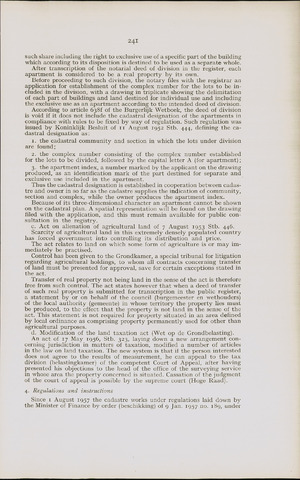241
such share including the right to exclusive use of a specific part of the building
which according to its disposition is destined to be used as a separate whole.
After transcription of the notarial deed of division in the register, each
apartment is considered to be a real property by its own.
Before proceeding to such division, the notary files with the registrar an
application for establishment of the complex number for the lots to be in
cluded in the division, with a drawing in triplicate showing the delimitation
of each part of buildings and land destined for individual use and including
the exclusive use as an apartment according to the intended deed of division.
According to article 638f of the Burgerlijk Wetboek, the deed of division
is void if it does not include the cadastral designation of the apartments in
compliance with rules to be fixed by way of regulation. Such regulation was
issued by Koninklijk Besluit of n August 1952 Stb. 444, defining the ca
dastral designation as:
1. the cadastral community and section in which the lots under division
are found;
2. the complex number consisting of the complex number established
for the lots to be divided, followed by the capital letter A (for apartment)
3. the apartment index, a number marked by the applicant on the drawing
produced, as an identification mark of the part destined for separate and
exclusive use included in the apartment.
Thus the cadastral designation is established in cooperation between cadas
tre and owner in so far as the cadastre supplies the indication of community,
section and complex, while the owner produces the apartment index.
Because of its three-dimensional character an apartment cannot be shown
on the cadastral plan. A spatial representation will be found on the drawing
filed with the application, and this must remain available for public con
sultation in the registry.
c. Act on alienation of agricultural land of 7 August 1953 Stb. 446.
Scarcity of agricultural land in this extremely densely populated country
has forced government into controlling its distribution and price.
The act relates to land on which some form of agriculture is or may im
mediately be practised.
Control has been given to the Grondkamer, a special tribunal for litigation
regarding agricultural holdings, to whom all contracts concerning transfer
of land must be presented for approval, save for certain exceptions stated in
the act.
Transfer of real property not being land in the sense of the act is therefore
free from such control. The act states however that when a deed of transfer
of such real property is submitted for transcription in the public register,
a statement by or on behalf of the council (burgemeester en wethouders)
of the local authority (gemeente) in whose territory the property lies must
be produced, to the effect that the property is not land in the sense of the
act. This statement is not required for property situated in an area defined
by local ordinance as comprising property permanently used for other than
agricultural purposes.
d. Modification of the land taxation act (Wet op de Grondbelasting).
An act of 17 May 1956, Stb. 323, laying down a new arrangement con
cerning jurisdiction in matters of taxation, modified a number of articles
in the law on land taxation. The new system is that if the person interested
does not agree to the results of measurement, he can appeal to the tax
division (belastingkamer) of the competent Court of Appeal, after having
presented his objections to the head of the office of the surveying service
in whose area the property concerned is situated. Cassation of the judgment
of the court of appeal is possible by the supreme court (Hoge Raad).
4. Regulations and instructions
Since 1 August 1957 the cadastre works under regulations laid down by
the Minister of Finance by order (beschikking) of 9 Jan. 1957 no- I^9> under

